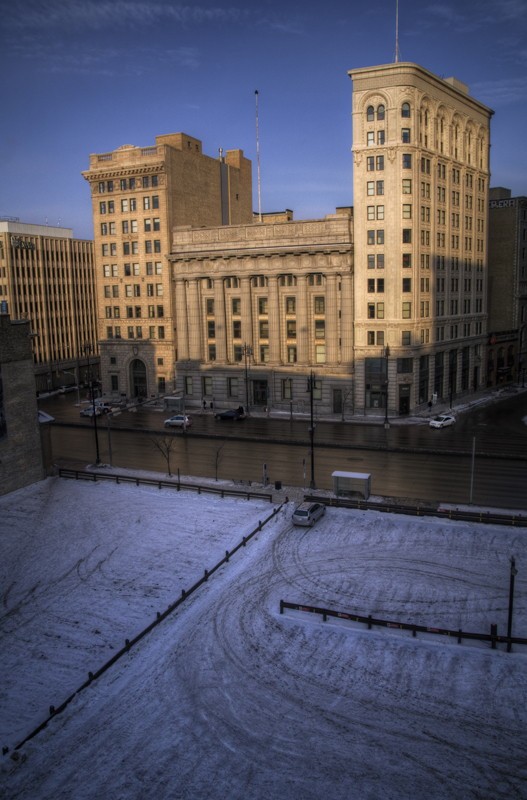Downtown dialogue
Two urban writers exchange thoughts about what Winnipeg is and could be
It is common knowledge that downtown Winnipeg requires revitalization.
From debates in city council to everyday chatter, everyone can seem to pinpoint something completely wrong with the city’s centre.
Some of the most reiterated complaints include a lack of people after 5 p.m., crime, inadequate and expensive housing, and anti-pedestrian design.
That there are problems with downtown Winnipeg is irrefutable.
The problem, decades in the making, seems to be how to solve them.
Some of the best information on Winnipeg’s urban and civic issues can be gained from the city’s impressive number of thought-provoking urban bloggers.
The Uniter asked two of the best, Robert Galston and Walter Krawec, to discuss with each other the quirks, blunders and glimmers of hope that mark downtown Winnipeg today.
What follows is a dialogue between two of Winnipeg’s respected urban thinkers about the state of the downtown today.
Dear Robert,
There aren’t many issues in this city that have consumed more ink than the state of downtown Winnipeg.
Hand-wringing over Winnipeg’s urban core has been a constant over the past five decades, and promises to cure what ails downtown are a part of every civic election.
But for all the discussion, debate and promises, what has actually changed?
To answer that question, it is useful to look back to the mid to late 1990s, an economically lacklustre period when downtown Winnipeg was at a low point.
During those years, the last pretenses of downtown as a retail hub for the city were shaken off as Eaton’s closed for good in 1999.
In addition, many retailers on Portage Avenue and in downtown malls were replaced with vacant spaces and “For Lease” signs, a reflection of diminishing traffic in the area.
The corporate presence, while still significant, was slowly declining as head offices and district offices were lost to other cities.
Federal Industries Ltd., United Grain Growers, the big banks – there seemed to be no end.
To top it off, residential neighbourhoods near downtown were becoming distressed as low property values and rising crime transformed areas like West Broadway and the West End from tidy working class communities into relatively menacing places.
If it looks like I’m overstating the problems of the 1990s, it’s important to remember that downtown Winnipeg’s trajectory appeared quite ominous and there was a sense that things had to change quickly before they reached a point of no return.
Since those days, we’ve seen many signs of progress in downtown Winnipeg.
As any look at the array of promotional materials will tell you, the last 15 years have seen many important projects take shape downtown.
Most Winnipeggers are well acquainted with the big-ticket developments like the MTS Centre, Manitoba Hydro Place, Red River College and the Canadian Museum of Human Rights.
There have also been many smaller projects such as the adaptive re-use of heritage buildings, particularly within the Exchange District.
But for all the press releases, project announcements and ribbon cutting ceremonies, something is still missing.
While we have some impressive new buildings and some wonderfully restored heritage buildings, many of them stand in isolation.
We haven’t seen much in the way of downtown population growth or the emergence of cohesive precincts to draw people in. There is still a lot of work to be done.
Walter
“ Without a new way of thinking that values density, a strong sense of place and scale, and a dynamic entrepreneurial climate, we would just be condemning ourselves to another 40 years in the hamster wheel of downtown revitalization.
Robert Galston, local blogger, The Rise and Sprawl
Hey Walter,
I tend to wince when I read that there is “still a lot of work to be done” downtown, only because it seems to imply that meaningful work has been done already and that it simply must be continued at a greater pace.
What’s disconcerting is that it seems the prevailing vision is a continued reliance on micromanaging major-scaled development and providing lots of parking.
This has gone on downtown for some 40 years, and it seems that current plans seem to follow this pattern.
If there is work to be done, it should begin with looking at how successful downtown districts work and grow organically.
Very little attention has been paid to the context and texture of development downtown, how it contributes or detracts from the public realm.
We should ensure that development is not only mixed-use, but has a humane scale and is oriented to the sidewalk.
The failure to do that is best exemplified in the blocks between Broadway and Ellice Avenue.
More than just vast parking lots, most of the buildings there are completely incompatible with dynamic pedestrian and business environments.
The tragic part is that so much of this deplorable condition came as a result of several generations of visionary urban renewal attempts.
These blocks do not suffer from a lack of major attractions, a strong workforce or places to park (and this was true even in the bad old days of the 1990s).
Maybe after nearly half a century of trying to beat the suburbs at their own game by creating major attractions and lots of parking, we could try something else.
Rob
Hi Robert,
You’ve touched on one of the major flaws of the well-intentioned, but so far unsuccessful, attempts at downtown revitalization over the years.
For about as long as there have been attempts at improving the city’s central business district, the answers (at least as far as local politicians are concerned) typically lie in monolithic megaprojects, which generally receive public money in one form or another.
The Civic Centre, the Centennial Centre, the Convention Centre, the MTS Centre (have I missed any centres?) and Portage Place are perhaps the most obvious examples.
Plus, they are about as far as you can get from the stately old brick edifices of the Exchange District, which have arguably been much more successful in drawing a crowd downtown.
What has really eluded the City of Winnipeg is a way to encourage the fine-grained development of smaller projects to go between all of the monoliths.
For all the energy directed towards expensive, high-profile downtown revitalization projects, there doesn’t seem to be nearly as much interest in the policy instruments at the city’s disposal which might encourage smaller developments – the kinds of projects that can be built and operated by local businesspeople.
Now, I have to give credit where it’s due. The downtown zoning bylaw passed in 2004 was specifically aimed at easing the regulatory burden.
But one bylaw is only part of the answer.
What about detailed design requirements that specify appropriate types of development – exactly the humanely scaled, sidewalk-oriented designs you mentioned?
Frontage levies for commercial properties that reward density (and discourage surface parking)?
Increased tax increment financing activity?
Even if these specific ideas don’t pass with the city, there are other zoning and tax policy tweaks that could encourage more (and better) downtown development.
Walter
Hi Walter,
Small-scale projects don’t make for big headlines, and are more susceptible to the ups and downs of the market. But, they are ultimately the right thing to do.
One of the consequences of decades of focusing on public and major private developers is that it has inhibited small owners from doing anything with their properties downtown.
Small investors see building downtown as too complicated and costly, and as being the government’s “job” anyway.
You’re right about the downtown zoning bylaw. What is important about it is that it officially recognizes that density and urban forms are acceptable in downtown Winnipeg.
Infill development is going to be complicated and expensive compared to building in the suburbs. Land costs more, and elevators and steel construction is required for anything taller than four stories, so any needless regulatory barrier that can be removed is essential.
City Council does have a downtown design review committee, but as anyone that has walked down Main Street in the last couple of years knows, design standards are very selectively applied.
Not every building need replicate the Exchange District; contemporary architectural styles can be built on a humane scale and possess a relationship to the street, too. I’ve seen this in infill projects in New York and Chicago.
Rob
Dear Robert,
There have been some small development projects that have sprouted in unlikely parts of downtown over the past decade. The challenge is to stimulate more of them, in sufficiently close proximity that they lead to a critical mass of people and activity.
For example, the Maxim Bakery & Pastry on Alexander Avenue added a street-front retail destination to a desolate block in Chinatown.
The Pullan Kammerloch Frohlinger offices on Kennedy Street filled a gap in the streetscape.
Unfortunately, these types of developments have proven to be the exception. They are outnumbered by massive projects that more often sit like closed fortresses on the street and, of course, vacant lots that remain vacant for decades.
It would be a bold statement if one of the many government-owned parking lots downtown were subdivided, as you suggested, and opened up to developers willing to build small projects appropriate for an urban area (and not ones that belong on Pembina Highway).
But as long as the focus remains on monumentally scaled megaprojects, the many smaller projects essential to a successful downtown will continue to be overlooked.
Walter
Hey Walter,
The small projects you listed demonstrate the tricky and sometimes frustrating aspect of small, privately led developments in Winnipeg.
They have been too few and far between (geographically speaking), and it is impossible to predict where they will go, or to properly coordinate where they ought to go.
But they are still small steps in the right direction.
While we have been talking mostly about new construction, it’s important to remember that old buildings are much more economical for small enterprises, and they play a crucial role in making districts successful.
Governments should do as much as possible to ensure small, urban projects occur with greater frequency, either through the re-use of old buildings or the construction of new ones.
Eventually, some kind of concentration or pattern emerges, which will further increase the viability of investing downtown.
This may have more to do with getting out of the way than playing a leading role.
The unfortunate part is that it seems the political engine driving the current wave of “revitalization” downtown – City Council and myriad revitalization agencies – is not concerned with making downtown livable, walkable or economically dynamic.
I hope that in the coming years, citizens demand an end to these self-serving megaproject schemes.
Without a new way of thinking that values density, a strong sense of place and scale, and a dynamic entrepreneurial climate, we would just be condemning ourselves to another 40 years in the hamster wheel of downtown revitalization.
Rob
Robert Galston is a University of Winnipeg student who writes about urban issues at http://riseandsprawl.tumblr.com. Walter Krawec is a graduate of the University of Winnipeg and University of Manitoba’s joint Master of Public Administration program. He blogs about urban issues at www.onemancommittee.com.
Published in Volume 65, Number 25 of The Uniter (March 31, 2011)











